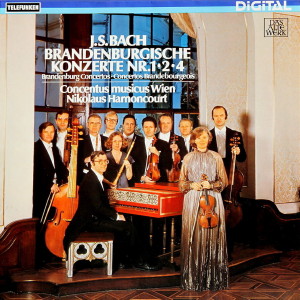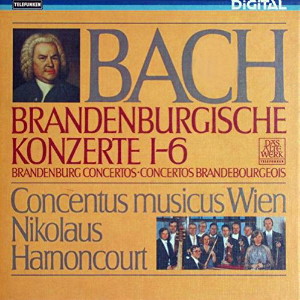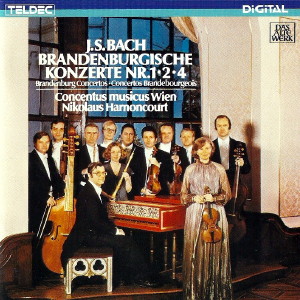 |
1 LP -
6.42823 AZ - (p) 1981
|
 |
| 2 LP -
6.35620 FD - (c) 1982 |
 |
| 1 CD -
8.42823 ZK - (c) 1983 |
|
Johann Sebastian
Bach (1685-1750) - Brandenburgische
Konzerte 1 - 2 - 4
|
|
|
|
|
|
|
|
| Brandenburgisches Konzert
Nr. 2 F-dur, BWV 1047 |
|
11' 46" |
A1 |
| (Concerto 2do á 1 Tromba 1
Fiauto 1 Hautbois 1 Violino, concertati, è
2 Violini 1 Viola è Violone in Ripieno col
Violoncello è Basso per il Cembalo.) |
|
|
|
| - (Allegro) |
5' 20" |
|
|
| - Andante |
3' 28" |
|
|
- Allegro assai
|
2' 58" |
|
|
| Brandenburgisches Konzert
Nr. 4 G-dur, BWV 1049 |
|
15' 52" |
A2 |
| (Concerto 4to á Violino
Prencipale, due Fiauti d'Echo, due
Violini, una Viola è Violone in Ripieno,
Violoncello è Continuo.) |
|
|
|
- (Allegro)
|
7' 04" |
|
|
- Andante
|
3' 55" |
|
|
- Presto
|
4' 53" |
|
|
| Brandenburgisches Konzert
Nr. 1 F-dur, BWV 1046 |
|
20' 00" |
B |
| (Concerto 1mo á 2 Corni di
Caccia, 3 Hautb: è Bassono. Violino
piccolo concertato, 2 Violini, una Viola è
Violoncello, col Basso Continuo.) |
|
|
|
| - (Allegro) |
4' 05" |
|
|
| - Adagio |
4' 00" |
|
|
| - Allegro |
4' 15" |
|
|
- Menuet, Trio,
Polonesche, Trio
|
7' 40" |
|
|
|
|
|
|
CONCENTUS MUSICUS WIEN (mit
Originalinstrumenten)
|
|
| -
Hermann Baumann, Naturhorn |
-
Karl Höffinger, Violine |
|
| -
Marcus Schleich, Naturhorn |
-
Anita Mitterer, Violine |
|
| -
Friedemann Immer, Naturtrompete |
-
Walter Pfeiffer, Violine |
|
| -
Elisabeth Harnoncourt, Flauto |
-
Andrea Bischof, Violine |
|
| -
Marie Wolf, Flauto (4), Hautbois
(Nr.1) |
-
Wilhelm Mergl, Violine |
|
| -
Jürg Schaeftlein, Hautbois |
-
Kurt Theiner, Viola |
|
| -
David Reichenberg, Hautbois
(Nr.1) |
-
Josef de Sordi, Viola |
|
| -
Milan Turković, Bassono |
-
Wouter Möller, Violoncello (Nr.1) |
|
| -
Alice Harnoncourt, Violino
piccolo (Nr.1), Violino conc.
(Nr.2), Violine |
-
Nikolaus Harnoncourt,
Violone/Violono grosso (Nr.1) |
|
| -
Erich Höbarth, Violine |
-
Eduard Hruza, Violone |
|
| -
Peter Schoberwalter, Violine |
-
Herbert Tachezi, Cembalo |
|
|
|
| Nikolaus
Harnoncourt, Leitung |
|
|
|
Luogo e data
di registrazione
|
| Grosses Tonstudio Rosenhügel,
Vienna (Austria) - gennaio 1981 |
|
Registrazione
live / studio
|
| studio |
Producer / Engineer
|
-
|
Prima Edizione
CD
|
Teldec "Das Alte Werk" -
6..42823 ZK - (1 cd) - 48' 25" - (c)
1983 - DDD
|
Prima
Edizione LP
|
- Telefunken "Das Alte Werk" -
6.42823 AZ - (1 lp) - 48' 25" - (p) 1981
- Digital
- Telefunken "Das Alte Werk" -
6.35620 FD - (2 lp) - 48'25" + 50' 10" -
(c) 1982 - Concerti I-VI |
|
|
Notes
|
The
Brandenburg Concerti are in
fact a selection from the
music Bach composed for the
court orchestra, the Hofkapelle,
during his time at Köthen.
Bach dedicated these six
concerti, which had all been
composed some time before,
to the Margrave of
Brandenburg,
and took the opportunity to
write
all six into a combined
dedicatory
score. What I feel is
important here is that the
concerti were not, as was
usually the case, adapted to
the musical abilities of the
dedicatee; rather, they
represent a colourful
pattern book
of the composer’s
art.
One must bear this in mind
to explain the remarkable
fact that these
concerti have nothing
whatsoever in common exccpt
the names of the composer
and the dedicatee - as
individual works they are as
different
as was conceivable at the
time:
each concerto is
scored for a different
combination of instruments
and soloists; Bach follows
different structural
principles in each
case. The
concertante playing of a
soloist or group of soloists
as a dialogue or contest
with a ripieno group - in
this case a small string
orchestra - is occasionally
reduced here to a purely
formal, only musically
recognisable idea (for
example, in the slow
movement of concerto no. 5
or in the entire 3rd and 6th
concerti). These
six concerti, then,
represent in every respect
the maximum possible differentiation
and variety. Diversity
takes precedence over
uniformity.
Brandenburg Concerto no. 1 is
one of the earliest works in
musical history in which the
hand horn is employed as a
solo instrument across the
entire breadth of its
capabilities. The entry of
this instrument into the
intimate sphere of refined
salon music must have
created a sensation. The
hunting horn
(corno
di caccia) was principally
used in hunting, different
horn signals serving to keep
the widely
scattered
groups informed on the
progress of the hunt.
This genuine “open-air"
instrument was blown mainly
by the huntsmen themselves
and their attendants. Even
the
horn-players in the first
performances of Bach’s
concerto may well
have been travelling
“huntsmen-virtuosi”; this
is, at all events, made very
clear by
their entrée
in the first tutti, a real
hunting fanfare, in which the quavers
are adapted to the triplet
rhythm characteristic of the
hunt. The rest of the
orchestra, apparently
unmoved by the
horn signals with their
quite unwonted form
and rhythm, plays a quite "normal"
Bachian orchestral tutti.
The concertante playing
already stands out here
with the alternating of the
oboes
and strings in bars 6-7;
from bar 9 onwards the
horns are brought in as full
concerto partners, and Bach
uses the intonationally extreme
natural notes F, F sharp and
A (the
eleventh and thirteenth
harmonics) from the start.
Since the musical sound
groups of
"figures" in
this movement correspond to
common, well-known forms,
Bach was able to leave the
very necessary articulation
up to the musicians. We
therefore
put in and performed the
articulation markings
according to contemporary
usage. In the first movement
the concertante playing
comes out, between real
tutti blocks, as a
confrontation (something of
a vehement dialogue)
beetween the
three groups horns, woodwind
and strings. In the second
movement the solo oboe, the
violino piccolo
(a small violin, tuned a
minor third higher, which
produces an odd, acute
sound) and the bass group
imitate each other on a
refined, impressionistic
basis. Here
the most unusual
articulation is specified by
the composer. The first
four
bars belong to the solo
oboe, whose notes,
determining the harmony, are
harmonically reinforced by
the second and third oboe
and the double-basses. The
strings provide
accompaniment with the bow
vibrato so beloved at the
time for sensitive places -
these four
bars are repeated in the
upper fifth by the violino
piccolo, during which the
woodwind and the strings
exchange roles (the bow
vibrato is now a
"frémissement" on the wind
instruments). The rewith the
material which is to be
developed is set out. Next,
in a three-part sequence,
the motif is first
taken over the bass, while
the strings and the woodwind
play in stretto a kind of
accompaniment motif; the
solo oboe and the violino piccolo
then take up the motif in
stretto, and this is
followed by a three-bar
transition This sequence is
repeated twice - one has the
impression that it could go
on forever -
only to break off abruptly
during second repeat at the
bass motiv. The beginning of
the stretto one was
expecting here becomes an
oboe cadenza,
while the three-part bass -
oboes - strings sequence is
brought once
more into prominence by
alternating chords in the
unexpected conclusion. The
third movement is a true
concerto movement with six
rondo-like tutti blocks; the
principal soloist is the
violin piccolo, seconded by
the first horn and the first
oboe. The second tutti is
somewhat remarkable in that
it is played pianissimo: in
movements of this kind one
expects every tutti section
to be
forte; it is permeated by
unusual oboe and violin
solos. The fourth solo
(violino piccolo and first
ripieno violin) falls apart
into an adagio
chord, then is set going
again by what seems to bc
deployment of the rondo
theme -the real tutti
sections follow four bars
later. Although this
movement has the character
of a finale, it is followed
in turn by a minuet with the
most varied trio
combinations. It
was quite customary at the
beginning of the eighteenth
century (eg. Handel’s
concerti grossi) to conclude
exciting or stormy concerti
with a soothing minuet, in
order to send the listener
away in a relaxed frame of
mind.
Brandenburg Concerto no. 2
shows a profuse
rhetorical conception. It
turns out to be a complex
musical dialogue, in which
inversions and other devices
are used. Time afte rtime,
there is an exchange of
parts between the outer
instruments. The
instruments’ idiomatic
language (the scoring of the
solo quartet isextreme: a
high natural trumpet, a
recorder, an oboe, and a
violin, almost a repertoire
of the different ways of
producing sound) achieves an
impression of imitation by
the transfer of specific
instrumental figures to
other instruments.
In the first movement there
is a number of purely
tutti motifs, and several
others that are only played
by the soloists. In that
manner alone dialogue
results. Bach failed to
specify any dynamics, which
shows that he expected the
dynamic relations usual at
the time: solo sections were
played piano, tuttis as a
rule forte. (This of course
is quite the opposite
ofpresent-day practice.) The
soloist did not need to
struggle against the tutti,
as he was not accompanied by
the body of the orchestra,
but rather conducted
a dialogue with them. The
challenging initial
statement from the tutti is
succeeded by the protests of
the solo instruments and the
tutti reaction. It is
important to note that in
these various assertions the
different parts are often
simultaneously differently
articulated. Sometimes
this is expressly noted by
Bach. Varying articulation
in the different
parts results in a more
varied overall sound, with
the characters of the
individual instruments
becoming more distinct. Bach
obviously also expects
differing articulation when
a figure appears several
times, since the figure then
has an altered meaning in
the rhetorical context.
Analogy in the modern sense
is non-existent in Baroque
music, on account of its
similarity to conversation.
The second movement has a
double emotional
personality, one side coming
from the bass, the other
from the solo instruments.
The andante marking refers
primarily to the bass, which
proceeds in continuous
quavers that are to be
played at a steady pace.
Bach sets this ostinato
uniformity as a
counterweight to the strong
expressiveness of the three
upper parts.
The third movement begins
with a trumpet solo, which
runs contrary to the
tradition of the Baroque
concerto movement and of
Baroque rhetoric, for the
statement that opens the
movement is normally made by
the tutti and then
questioned by the solo.
Here, the preceding movement
leads directly into this
solo, which is an answer to
the last figure of the
second movement; therefore
there can be no pause
between these two movements.
The tutti just plays an
orchestral continuo here:
accompaniment, and the
thematic events, are
developed by the soloists
and the bass alone. In terms
of the concerto’s dramatic
layout, that means that the
entire finale is an
enumerated acceptance of the
challange
of the first movement.
In
the Brandenburg Concerto no.
4 the marking flauti d’echo
poses something of a puzzle
at first sight. High octave
flutes were occasionally
used, but
these have much louder
effect than ordinary
recorders, so that the
orchestra would then be the
“echo”. Bach surely meant
normal recorders. In the
first rnovement the roles of
the concertino are clearly
given out to the group of
soloists: the violin is the
main soloist, seconded by
the pair of recorders which
are also brought to the fore
again later in a lyrical
solo section (bars l57-185
and 285-311). The echo
effect in the second
movement may have heen so
important for Bach that he
included it in the title of
the concerto. The idea of
the echo here is a rapid
interruption of the melody,
which would proceed
continuously but for these
echo insertions. The echos
are at
those points where one ought
to write in a comma; they
force one to listen
attentively. The effect
which Bach seems to have
intended can only be
achieved if the flutes are
played from an adjoining
room. At points where they
are independent, as in bar
40, the orchestra must play
more quietly to balance the
sound. The andante marking
of the second movement seems
to refer to the tempo here,
and not to an “andante”
character of the whole
movement. The slow movement
should, then, receive a
gradual acceleration; the
paired quavers are not
played steadily here. A
fundamental feature of this
movement is the perfect
symmetrical arrangement,
which is comparable with the
architecture of a Baroque
palace, and which Bach uses
time and time again in his
major works. Around a
central section (bars 28-45)
are grouped four outer
sections. by
way of framing: of these,
the first and fifth only
differ in the interchanging
of the outer parts. The
second and fourth
sections correspond too,
with the difference that the
echoes in the 4th section
have a compressed effect. In
the central section there is
new material and a new
dialogue in that the
recorders voice soloistic
complaints here. In
the fifth
section the theme is in the
hass,
and the echoes of the
symmetrically matching first
section
are omitted: they would not
make sense in the repeat,
since the effect would no
longer be new. For
interpretation it is most
important to recognise this
symmetry - one would play
the piece difierently if the
sections were just
arranged in a row.
Although the third movement
is to be played directly
after the
second, without a
break, the recorder players
have time to return to their
places, since they do
not come in until bar
23. In this movement the
entire thematic material is
derived from the first four
bars.
Nikolaus
Harnoncourt
Translation:
Clive R. Williams
|
|
Nikolaus
Harnoncourt (1929-2016)
|

|

|
|